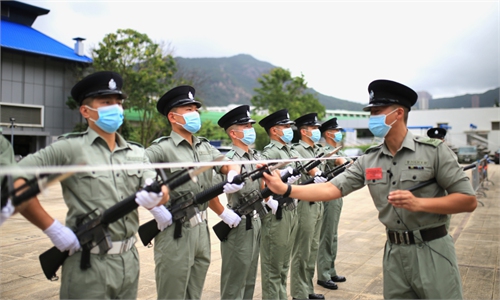1st batch of trainees to adopt Chinese-made pistols in HKPF to finish on Thursday, plan under consideration ‘for some time’

Hong Kong Police Force unveils the plan to replace current US-made pistols with two models of Chinese-made pistols. Photo: Sing Tao Daily
The first batch of trainees to adopt two models of Chinese-made pistols to replace the current US-made pistols is expected to finish on Thursday. The Hong Kong Police Force announced the replacement plan earlier this month, which has been under consideration within the police force for some time, people familiar with the matter told the Global Times.The Hong Kong Police Force (HKPF) continually reviews and updates or replaces equipment as needed, such as firearms.
After an extended period of research and testing, the police force will launch a plan to replace their firearms within the year and has decided to use two new 9-millimeter mainland pistols — CF98-A and CS/LP5, replacing the current S&W Model 10 revolvers and SIG P250 pistols used by uniformed patrol officers.
The newly adopted domestic pistols excel in performance and reliability, and the HKPF will phase in over time and include training and replacement schedules for the new pistols in batches.
The police also plan to start training new recruits on the use of the domestic pistols in September, marking the beginning of a new era of adopting Chinese-made firearms.
Hong Kong police’s emergency unit, tactical unit, and quick reaction force and personnel from the police’s headquarters crime wing will be the first to undergo the initial phase of pistol training courses. Other personnel will subsequently receive training in stages, the Global Times learned.
The first batch of officers to complete the training will begin duty with the new semi-automatic pistols starting on Thursday, while those who have not yet been trained will continue to use the existing pistols.
Superintendent Ko Cheuk-hang from the police’s support wing told a press conference earlier this month that the new semi-automatic pistols meet three key criteria, fulfilling the law enforcement needs of officers. In terms of safety, the new pistols are equipped with a manual safety catch, effectively reducing the risk of accidental discharge.
Regarding shooting speed, the new pistols allow for quicker reloading, with each pistol capable of holding 15 rounds, and reloading requires only the replacement of the entire magazine.
In terms of stability, the new pistols effectively reduce recoil during shooting, enhancing overall accuracy and control. Additionally, the grip design is better suited to the hand size of Asian users, enabling officers to aim more easily and thereby improving shooting stability and accuracy.
“In fact, the replacement of pistols has been considered within the police force for quite some time. Given the issues related to the repair, maintenance, and supply of parts for the old pistols, a complete replacement is necessary for efficiency and to effectively meet future operational needs,” Junior Police Officers' Association Chairman Lam Chi-wai told the Global Times.
A Chinese military expert and TV commentator who preferred not to be named told the Global Times that the replacement program is just a case of normal procedure.
China's capabilities in firearms production and development have reached a world-leading level. Given this, the HKPF has the right to select firearms globally that best suit their needs. This selection includes firearms from the US, China, and other countries. The final decision was undoubtedly made after comprehensive testing, concluding that Chinese-made firearms are more suitable for the Hong Kong police force, he said.
“This also indicates that the quality and performance of Chinese firearms are continuously improving, gaining the recognition of the Hong Kong police. Hong Kong is an international city with a wide range of exposures, and this conclusion was reached through extensive comparisons,” the expert noted.


